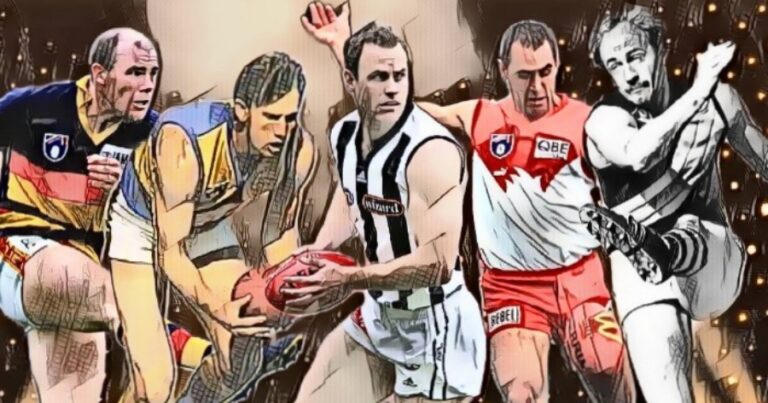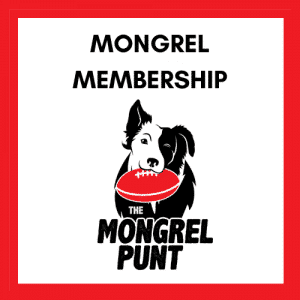There are some players who stand out in our memories and many of us, myself included, have lionised them over the years, making them seem grander than perhaps they really were.
The AFL Hall of Fame is littered with players who excelled at the highest level and achieved enormous feats of brilliance on the field, but not all players we’ll cover here will have been announced as part of the game’s elite.
Here at The Mongrel Punt, we have always endeavoured to look a little beyond the obvious, flitter between household names and some that maybe… just maybe have slipped your mind over the years.
In this series profiling the heroes of the game, we look at some of the players who were vital to their teams’ success in different capacities.
And believe me – there are plenty of them. And we ask – just how good were they?
The first of this series can be found HERE.
BRETT HEADY
When a team has a player like Brett Heady, they are always dangerous. The type to make something out of nothing, Heady was a hit as soon as he debuted for the West Coast Eagles in 1990, immediately establishing himself as a threat in front of goal with a healthy 1.2 average in his rookie season., Add to that 18.7 touches per game, and West Coast knew they had something special.
With these early 1990s Eagles teams, it was as though they had a million ways to beat you. Their defence was rock solid, their midfield was growing in strength almost by the game, and up forward… well, this is where Brett Heady came to the fore.
His career was short in comparison to many others. He was done by 1999, but in his case, it was more how bright the flame burnt than how long it burned for. He was instrumental in the relentless push of the Eagles in 1991, kicking bags of seven, five and four throughout the season, and on what was a disappointing day for West Coast in the Grand Final, Heady’s four goals saw him walk off with his head held high.
In that 1991 finals series, Heady averaged over 17 touches and 2.3 goals per game in a clear indication that West Coast had unearthed a star.
Then how he is so easily forgotten by Non-Eagles fans?
Because they had stars everywhere!
Injury interrupted his 1992 campaign before he was able to settle and be part of the inaugural West Coast premiership. He was front and centre again in ‘94, averaging a massive 3.7 goals per game across the three finals en route to lifting the cup again.
Never a best and fairest winner, and never an All-Australian, Brett Heady played footy at the highest level like he was having fun. He kicked goals and collected the footy with ease and had a habit of making things happen when it appeared as though it was a bit of a stalemate.
He particularly loved playing against the Saints, averaging over three goals per game against them for his career.
JAMES CLEMENT
In the previous version of this column, I talked up Guy McKenna as one of the best half-backs you’re likely to see play the game.
This bloke is right up there with him.
James Clement was a pillar of strength for Collingwood after playing five years at Fremantle from 1996. Used as both a defender and forward at Freo, Clement’s move to the Magpies would be the avenue for him to excel at the top level. He was serviceable for the Dockers, but it was with Collingwood that he shined brightest, picking up two All-Australian selections and notching two Copeland Trophies along the way.
Clement’s retirement at the conclusion of the 2007 season came as a complete shock to most, as he was coming off another really strong year, but it was later revealed that Clement was walking away to be able to care for his wife, who was suffering autoimmune kidney failure. A Kidney transplant would later save her life.
Clement was just 31 when he retired and looked to have plenty left in the tank, but made a responsible and noble decision to devote more time to his family. He is one I reckon that still has untapped knowledge about the game and would make an incredible addition to any coaching panel, just by watching the way he played. There are plenty of people who are said to have a footy brain, when people describe their aptitude for the game. Clement was one of those, but I reckon he has a better heart.
ROBERT WILEY
He arguably played his best footy in the WAFL, winning eight best and fairest awards for Perth between 1974 and 1986. In the middle of that tenure came four seasons with Richmond, in which Wiley added another dimension to the powerful team that won the flags in 1980.
And it was in that tenure that I became familiar with the work of Wiley. Even though I was a kid, his skill still stands out in my mind.
In 1980, Geoff Raines was the raging favourite to win the Brownlow Medal, but I believe the depth of the Richmond team absolutely killed him. Part of that was the brilliance of Wiley. He was a monster playing both on the ball and drifting forward, kicking 29 goals for the season and averaging over 25 touches per game. That 1980 season saw him top 30 touches on six occasions, and kick multiple goals in eight games.
Whilst it is hard to argue against KB’s 1980 Norm Smith Medal, as he kicked the lazy seven goals, Wiley would have surely been in consideration, with 26 touches and three snags of his own. It capped a finals series that saw him average 28 touches and 1.7 goals per game.
Wiley would continue to star for the Tigers, notching a massive 33 disposal/seven-goal outing against the Bombers in 1982 before returning to WA after the ‘83 season.
Back at Perth for five seasons, he led the team in goal kicking in 84, 95, and 86 before once again playing in the VFL, this time for his home state West Coast Eagles. Now 32, Wiley’s time of being a dominant player was passed, and whilst he played 18 games and still managed to average 1.3 goals per game, he hung up the boots for good after that season.
His standout game in 1987 saw him notch 21 touches and four goals in a vintage Robert Wiley performance against the Dees in Round Nine, reminding everyone that they were watching one of the best to do it.
WAYNE SCHWASS
In the days before Wayne Carey became the heart and soul of the club… and in the end, the dagger in the heart of it, a young man named Wayne Schwass was the great hope to lead the next generation of players following the Schimmelbusch/Blight transition to the Larkin/German era failed to deliver a third premiership.
Commencing at Arden Street in 1988, it did not take long for Wayne Schwass to make his presence felt, jumping to average over 20 touches per game for North in his second season at the club and cementing himself as one of the young stars of the game with speed and a bit of youthful flair. He would continue to hit 20 touches per game repeatedly over his ten years with the club before being traded to Sydney as part of the deal to bring Shannon Grant to North Melbourne after one year in the Harbour City.
It was a deal that could be considered a win for both parties, as Grant was a star in the making and Schwass provided the Swans with some leadership right off the bat.
Despite collecting two Syd Barker Medals at the Kangaroos (1994/95), his last two years at North saw his output diminish as others emerged as players who would be the next generation of stars. However, in red and white, Schwass once again found his groove, winning the Bob Skilton Medal in his second season with the team. In that 1999 season, he averaged career-high numbers, topping 26 disposals per game.
It was revealed in 2006 that Schwass fought mental illness for large parts of his career, going as far as to reveal that he considered suicide following North Melbourne’s 1996 Grand Final triumph. He founded an organisation called Puka Up to support people suffering from mental health issues.
Whilst Schwass’ work in the mental health sector now seems to garner more publicity than his playing days, it’s well worth remembering that he was a genuine star of the game who went to another level after being traded.
ANDREW JARMAN
You don’t have to look too far to understand just how good Andrew Jarman was.
I mean, just ask him – he’ll tell you!
Whilst his younger brother was, and is regarded as one of the most skilful players to ever play the game, and has the premiership medals with the Adelaide Crows and the Hawks to solidify his status, Andrew was a casualty of the Malcolm Blight era, and was probably a year or two too old, or a step or two too slow to enjoy the fruits of his labour with the team.
However, that does not mean that Andrew was any less a player. A prolific ball-winner, I first became aware of how good he was when watching state games. For all the talk about how brilliant Greg Williams was by hand, I am a firm believer that Jarman was every bit the expert in that regard, as well.
Some of his work in traffic, freeing up teammates with brilliantly quick hands (and yes, more than a few “Crow Throws”) were as good as it gets. He was an integral part of the early success enjoyed by Adelaide after they debuted in the AFL, and his first couple of seasons playing on the ball saw him regularly rack up over 30 touches.
Playing alongside Tony McGuinness, Mark Bickley, and Chris McDermott, Jarman gave the Crows a wealth of experience in the guts and was pure joy to watch on a heavy ground, where he handled the footy as though it was dry.
Unlike his brother, he lacked penetration with his kicking, but his creativity with the footy more than made up for it.
Sure, his off-field personality may be a bit loud for some, but I cannot help feel for Jars. He was 25 when he started with Adelaide, and when they were ready to win the flag, he was just that little bit past it.
A shame… his celebration would have been spectacular.
Oh, and if you want to witness the Jarman brothers absolutely destroy a team, check out the link below. It is Jarman carnage.
Like this content? You could buy me a coffee – I do like coffee, but there is no guarantee I won’t use it to buy a doughnut… I like them more. And I am not brought to you by Sportsbet or Ladbrokes… or Bet365, or any of them.



